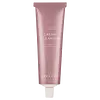What's inside
What's inside
 Key Ingredients
Key Ingredients

 Benefits
Benefits

 Concerns
Concerns

 Ingredients Side-by-side
Ingredients Side-by-side

Water
Skin ConditioningGlycerin
HumectantSesamum Indicum Seed Oil
EmollientRubia Cordifolia Root Powder
Skin ConditioningCetearyl Alcohol
EmollientCetearyl Glucoside
EmulsifyingGlyceryl Stearate
EmollientCetearyl Olivate
Sorbitan Olivate
EmulsifyingDehydroacetic Acid
PreservativeBenzyl Alcohol
PerfumingAcacia Senegal Gum
MaskingXanthan Gum
EmulsifyingTocopherol
AntioxidantPelargonium Graveolens Oil
MaskingSodium Benzoate
MaskingWater
Skin ConditioningDicaprylyl Carbonate
EmollientHydrogenated Polydecene
EmollientSimmondsia Chinensis Seed Oil
EmollientSorbitol
HumectantCetearyl Olivate
Sorbitan Olivate
EmulsifyingCetearyl Alcohol
EmollientPentylene Glycol
Skin ConditioningOlive Oil PEG-7 Esters
EmollientSodium Hydroxide
BufferingLauryl Betaine
CleansingPolysorbate 60
EmulsifyingDisodium EDTA
Parfum
MaskingBenzyl Salicylate
PerfumingXanthan Gum
EmulsifyingTocopherol
AntioxidantSodium Chloride
MaskingWater, Dicaprylyl Carbonate, Hydrogenated Polydecene, Simmondsia Chinensis Seed Oil, Sorbitol, Cetearyl Olivate, Sorbitan Olivate, Cetearyl Alcohol, Pentylene Glycol, Olive Oil PEG-7 Esters, Sodium Hydroxide, Lauryl Betaine, Polysorbate 60, Disodium EDTA, Parfum, Benzyl Salicylate, Xanthan Gum, Tocopherol, Sodium Chloride
Ingredients Explained
These ingredients are found in both products.
Ingredients higher up in an ingredient list are typically present in a larger amount.
Cetearyl alcohol is a mixture of two fatty alcohols: cetyl alcohol and stearyl alcohol. It is mainly used as an emulsifier. Emulsifiers help prevent the separation of oils and products. Due to its composition, it can also be used to thicken a product or help create foam.
Cetearyl alcohol is an emollient. Emollients help soothe and hydrate the skin by trapping moisture.
Studies show Cetearyl alcohol is non-toxic and non-irritating. The FDA allows products labeled "alcohol-free" to have fatty alcohols.
This ingredient is usually derived from plant oils such as palm, vegetable, or coconut oils. There is debate on whether this ingredient will cause acne.
Due to the fatty acid base, this ingredient may not be Malassezia folliculitis safe.
Learn more about Cetearyl AlcoholCetearyl Olivate is an emulsifier and texture enhancer. It is derived from the fatty acids of olive oil and Cetearyl alcohol, and is biodegradable.
As an emulsifier, it is used to prevent oils and waters from separating. It can also
Manufacturers use the name Olivem 1000. This ingredient has been found to preserve the natural microbiome of skin. Having a healthy microbiome helps keep our skin healthy and protects against harmful bacteria. This ingredient is grouped with Sorbitan Olivate under the name Olivem 1000.
Learn more about Cetearyl OlivateSorbitan Olivate is created from the fatty acids in olive oil and sorbitol.
This ingredient is an oil in water emulsifier. It helps stabilize a product by preventing oils and waters from separating. Sorbitan Olivate also helps hydrate the skin.
Manufacturers sell sorbitan olivate under the name OliveM 1000. OliveM 1000 a multifunctional ingredient. It is self-emulsifying. According to a manufacturer, OliveM 1000 does not disrupt natural skin biome.
Due to its olive oil base, this ingredient may not be fungal-acne safe.
Learn more about Sorbitan OlivateTocopherol (also known as Vitamin E) is a common antioxidant used to help protect the skin from free-radicals and strengthen the skin barrier. It's also fat soluble - this means our skin is great at absorbing it.
Vitamin E also helps keep your natural skin lipids healthy. Your lipid skin barrier naturally consists of lipids, ceramides, and fatty acids. Vitamin E offers extra protection for your skin’s lipid barrier, keeping your skin healthy and nourished.
Another benefit is a bit of UV protection. Vitamin E helps reduce the damage caused by UVB rays. (It should not replace your sunscreen). Combining it with Vitamin C can decrease sunburned cells and hyperpigmentation after UV exposure.
You might have noticed Vitamin E + C often paired together. This is because it is great at stabilizing Vitamin C. Using the two together helps increase the effectiveness of both ingredients.
There are often claims that Vitamin E can reduce/prevent scarring, but these claims haven't been confirmed by scientific research.
Learn more about TocopherolWater. It's the most common cosmetic ingredient of all. You'll usually see it at the top of ingredient lists, meaning that it makes up the largest part of the product.
So why is it so popular? Water most often acts as a solvent - this means that it helps dissolve other ingredients into the formulation.
You'll also recognize water as that liquid we all need to stay alive. If you see this, drink a glass of water. Stay hydrated!
Learn more about WaterXanthan gum is used as a stabilizer and thickener within cosmetic products. It helps give products a sticky, thick feeling - preventing them from being too runny.
On the technical side of things, xanthan gum is a polysaccharide - a combination consisting of multiple sugar molecules bonded together.
Xanthan gum is a pretty common and great ingredient. It is a natural, non-toxic, non-irritating ingredient that is also commonly used in food products.
Learn more about Xanthan Gum